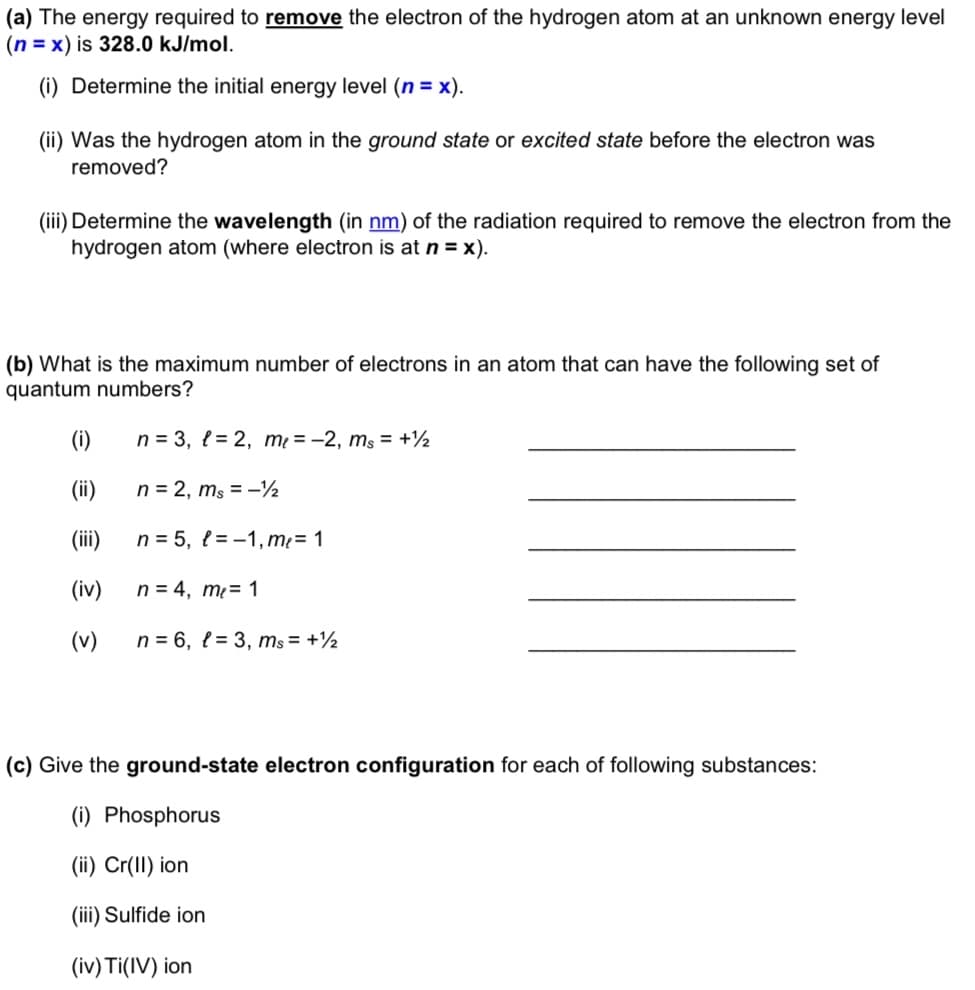a) The energy required to remove the electron of the hydrogen atom at an unknown energy le n = x) is 328.0 kJ/mol. (i) Determine the initial energy level (n = x). (ii) Was the hydrogen atom in the ground state or excited state before the electron was removed? (iii) Determine the wavelength (in nm) of the radiation required to remove the electron from hydrogen atom (where electron is at n = x). b) What is the maximum number of electrons in an atom that can have the following set of
a) The energy required to remove the electron of the hydrogen atom at an unknown energy le n = x) is 328.0 kJ/mol. (i) Determine the initial energy level (n = x). (ii) Was the hydrogen atom in the ground state or excited state before the electron was removed? (iii) Determine the wavelength (in nm) of the radiation required to remove the electron from hydrogen atom (where electron is at n = x). b) What is the maximum number of electrons in an atom that can have the following set of
Chemistry: The Molecular Science
5th Edition
ISBN:9781285199047
Author:John W. Moore, Conrad L. Stanitski
Publisher:John W. Moore, Conrad L. Stanitski
Chapter5: Electron Configurations And The Periodic Table
Section: Chapter Questions
Problem 141QRT
Related questions
Concept explainers
Atomic Structure
The basic structure of an atom is defined as the component-level of atomic structure of an atom. Precisely speaking an atom consists of three major subatomic particles which are protons, neutrons, and electrons. Many theories have been stated for explaining the structure of an atom.
Shape of the D Orbital
Shapes of orbitals are an approximate representation of boundaries in space for finding electrons occupied in that respective orbital. D orbitals are known to have a clover leaf shape or dumbbell inside where electrons can be found.
Question

Transcribed Image Text:(a) The energy required to remove the electron of the hydrogen atom at an unknown energy level
(n = x) is 328.0 kJ/mol.
(i) Determine the initial energy level (n = x).
(ii) Was the hydrogen atom in the ground state or excited state before the electron was
removed?
(iii) Determine the wavelength (in nm) of the radiation required to remove the electron from the
hydrogen atom (where electron is at n = x).
(b) What is the maximum number of electrons
quantum numbers?
an atom that can have the following set of
(i)
n = 3, { = 2, mı = -2, ms = +½
(ii)
n = 2, ms = -½
(ii)
n = 5, { = -1, m = 1
(iv)
n = 4, m= 1
(v)
n = 6, { = 3, ms = +½
(c) Give the ground-state electron configuration for each of following substances:
(i) Phosphorus
(ii) Cr(II) ion
(iii) Sulfide ion
(iv) Ti(IV) ion
Expert Solution
This question has been solved!
Explore an expertly crafted, step-by-step solution for a thorough understanding of key concepts.
Step by step
Solved in 2 steps with 1 images

Knowledge Booster
Learn more about
Need a deep-dive on the concept behind this application? Look no further. Learn more about this topic, chemistry and related others by exploring similar questions and additional content below.Recommended textbooks for you

Chemistry: The Molecular Science
Chemistry
ISBN:
9781285199047
Author:
John W. Moore, Conrad L. Stanitski
Publisher:
Cengage Learning

General Chemistry - Standalone book (MindTap Cour…
Chemistry
ISBN:
9781305580343
Author:
Steven D. Gammon, Ebbing, Darrell Ebbing, Steven D., Darrell; Gammon, Darrell Ebbing; Steven D. Gammon, Darrell D.; Gammon, Ebbing; Steven D. Gammon; Darrell
Publisher:
Cengage Learning

Chemistry
Chemistry
ISBN:
9781305957404
Author:
Steven S. Zumdahl, Susan A. Zumdahl, Donald J. DeCoste
Publisher:
Cengage Learning

Chemistry: The Molecular Science
Chemistry
ISBN:
9781285199047
Author:
John W. Moore, Conrad L. Stanitski
Publisher:
Cengage Learning

General Chemistry - Standalone book (MindTap Cour…
Chemistry
ISBN:
9781305580343
Author:
Steven D. Gammon, Ebbing, Darrell Ebbing, Steven D., Darrell; Gammon, Darrell Ebbing; Steven D. Gammon, Darrell D.; Gammon, Ebbing; Steven D. Gammon; Darrell
Publisher:
Cengage Learning

Chemistry
Chemistry
ISBN:
9781305957404
Author:
Steven S. Zumdahl, Susan A. Zumdahl, Donald J. DeCoste
Publisher:
Cengage Learning

Chemistry: Principles and Practice
Chemistry
ISBN:
9780534420123
Author:
Daniel L. Reger, Scott R. Goode, David W. Ball, Edward Mercer
Publisher:
Cengage Learning

Chemistry for Engineering Students
Chemistry
ISBN:
9781337398909
Author:
Lawrence S. Brown, Tom Holme
Publisher:
Cengage Learning

Chemistry & Chemical Reactivity
Chemistry
ISBN:
9781337399074
Author:
John C. Kotz, Paul M. Treichel, John Townsend, David Treichel
Publisher:
Cengage Learning